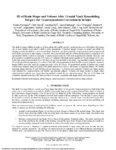Filters: Collection: "ir_uspace"
| Creator | Title | Description | Subject | Date | ||
|---|---|---|---|---|---|---|
| 1 |
 |
Schmidt, Meic H. | Cervical spine metastases: techniques for anterior reconstruction and stabilization | The surgical management of cervical spine metastases continues to evolve and improve. The authors provide an overview of the various techniques for anterior reconstruction and stabilization of the subaxial cervical spine after corpectomy for spinal metastases. Vertebral body reconstruction can be ac... | 2012-01-01 | |
| 2 |
 |
Schmidt, Meic H.; Apfelbaum, Ronald I. | Cervical spinal metastasis: anterior reconstruction and stabilization techniques after tumor resection | Object. In a review of the literature, the authors provide an overview of various techniques that have evolved for reconstruction and stabilization after resection for metastatic disease in the subaxial cervical spine. Methods. Reconstruction and stabilization of the cervical spine after vertebral... | Cervical spine reconstruction; Metastasis; Spine tumor; Corpectomy; Stabilization technique; Vertebral body | 2003 |
| 3 |
 |
Schmidt, Meic H. | Rod derotation techniques for thoracolumbar spinal deformity | OBJECTIVE: The operative correction of scoliosis requires multiple intraoperative techniques and tools to achieve an adequate result. Frequently, multiple methods are used to accomplish this, such as rod cantilever techniques, in situ bending, Smith-Petersen and pedicle subtraction osteotomies, clo... | 2008-01-01 | |
| 4 |
 |
Schmidt, Meic H. | Surgical technique and results of endoscopic anterior spinal canal decompression | Object. Decompression of the spinal canal in the management of thoracolumbar trauma is controversial, but many authors have advocated decompression in patients with severe canal compromise and neurological deficits. Anterior decompression, corpectomy, and fusion have been shown to be more reliable f... | Anterior approach; Anterior decompression; Spinal trauma; Endoscopy | 2005 |
| 5 |
 |
Dailey, Andrew T. | Diagnosis and treatment of craniocervical dislocation in a series of 17 consecutive survivors during an 8-year period | Object. Craniocervical dissociation (CCD) is a highly unstable and usually fatal injury resulting from osseoligamentous disruption between the occiput and C-2. The purpose of this study was to elucidate systematic factors associated with delays in diagnosing and treating this life-threatening condit... | Spinal cord injury; Craniocervical dislocation; Atlantooccipital joint; Atlantoaxial joint; Tetraplegia; CCJ; CCD | 2006 |
| 6 |
 |
Bisson, Erica F. | Management of distraction injury of the lumbosacral junction with unilateral perched facet | Background: Traumatic unilateral facet dislocation without fracture is an uncommon injury of the lumbosacral junction. We describe a case of a unilateral perched L5-S1 facet causing axial back pain and radiculopathy provoked by motion. ... | Spine surgery, Facet dislocation, operative management, trauma, neurosurgery | 2011-01-04 |
| 7 |
 |
Couldwell, William T. | Posterolateral approach for decompression with anterior and posterior fusion: a less invasive surgical technique for stabilization of the thoracic spine | The goals of surgery in unstable thoracic fractures or tumors involving the thoracic spine are neural decompression, correction of deformity, and stabilization. Several different approaches can be used to achieve these goals. The anterior, combined anterior and posterior, and more recently thoraco... | Decompression; Thoracic spine; Posterolateral approach | 1998 |
| 8 |
 |
Dailey, Andrew T. | Subaxial cervical spine trauma classification: the subaxial injury classification system and case examples | Object. The authors review a novel subaxial cervical trauma classification system and demonstrate its application through a series of cervical trauma cases. Methods. The Spine Trauma Study Group collaborated to create the Subaxial Injury Classification (SLIC) and Severity score. The SLIC system is... | Cervical spine trauma; Injury severity score; Spinal cord injury; Subaxial Injury Classification; SLIC; Discoligamentous integrity; Neurological status | 2008 |
| 9 |
 |
Dailey, Andrew T. | Thoracolumbar spine trauma classification: the Thoracolumbar Injury Classification and Severity Score system and case examples | Object. The aim of this study was to review the Thoracolumbar Injury Classification and Severity Score (TLICS) and to demonstrate its application through a series of spine trauma cases. Methods. The Spine Trauma Study Group collaborated to create and report the TLICS system. The TLICS system is re... | Thoracolumbar spine trauma; Classification; Thoracolumbar injury; TLICS; Spine Trauma Study Group; Thoracolumbar Injury Classification and Severity Score | 2009 |
| 10 |
 |
Lund, Dale A.; Caserta, Michael; Wright, Scott D. | Restoration after bereavement | The death of a spouse in later life, after many years of marriage is one of the most common of all major stressful life transitions. After age 65, 32% of the U.S. population is widowed (14% for men and 45% for women) with this increasing to 46% after age 75 and 66% after the age of 85 (U.S. Bureau o... | Dual process model; bereavement adjustment; loss orientation | 2004 |
| 11 |
 |
Dailey, Andrew T.; Brodke, Darrel S. | Timing and influence of MRI on the management of patients with cervical facet dislocations remains highly variable: a survey of members of the Spine Trauma Study Group | Background: Traumatic cervical facet dislocations are potentially devastating injuries. Magnetic resonance imaging (MRI) is an excellent means of assessing ligamentous disruption, disk herniation, and compression of the neural elements. However, despite an improved understanding of these facet dislo... | Cervical facet dislocations; MRI; Spine Trauma Study Group | 2009 |
| 12 |
 |
Podlog, Leslie William | Psychosocial factors in sports injury rehabilitation and return to play | The goal of this review is to provide insight into the principles and practices that guide psychological intervention with injury and in so doing cultivate a psychologically minded approach to injury for the medical provider. The chapter is divided into two parts. Part 1 provides an overview of the ... | 2014-01-01 | |
| 13 |
 |
Schmidt, Meic H. | Titanium cage-assisted polymethylmethacrylate reconstruction for cervical spinal metastasis | Reconstruction and stabilization of the cervical spine after vertebrectomy is an important goal in the surgical management of spinal metastasis. The authors describe their reconstruction technique using a titanium cage-Silastic tube construct injected with polymethylmethacrylate (PMMA) augmented by... | Titanium cage; Cervical spine; Cervical spinal metastasis; Reconstruction; Vertebrectomy; PMMA reconstruction; Silastic tube | 2005 |
| 14 |
 |
Seger, Jon | Evolution of individuality by Leo W. Buss | Metazoans seldom reproduce vegetatively; they often die of cancer; and they almost always sequester their germ lines. Plants often reproduce vegetatively, seldom die of cancer, and almost never sequester a germ line. Buss argues that these and many other patterns can all be understood in a unified w... | Cell lines; Hierarchy; Biology | 1988 |
| 15 |
 |
Couldwell, William T. | Use of cylindrical titanium mesh and locking plates in anterior cervical fusion | After performing anterior cervical corpectomy or discectomy for cervical spondolytic myelopathy or radiculopathy, iliac crest bone graft and fibular auto- or allograft is often used to achieve arthrodesis in the cervical spine. The purpose of this study was to evaluate the use of a cylindrical titan... | Anterior cervical fusion; Arthrodesis; Cylindrical titanium mesh; Lordosis; Kyphosis | 2001 |
| 16 |
 |
Schmidt, Meic H. | Minimally invasive thoracoscopic approach for anterior decompression and stabilization of metastatic spine disease | Object. The choices available in the management of metastatic spine disease are complex, and the role of surgical therapy is increasing. Recent studies have indicated that patients treated with direct surgical decompression and stabilization before radiation have better functional outcomes than thos... | Metastatic spine disease; Minimally invasive surgery; Spinal cord decompression | 2008 |
| 17 |
 |
McDaniel, Susan | Alice in demographyland: how it looks from the other side of the looking glass | The challenges are many in reflecting on women in demography in Canada in the 1990's. On the one hand, so much is known about women in academia and the hurdles that still need to be overcome " institutionally and intellectually. So much more research exists in the area than it did only a decade ago.... | Women; Universities; Academic life | 1992 |
| 18 |
 |
Schmidt, Meic H. | Role of thoracoscopic spinal surgery in the management of pyogenic vertebral osteomyelitis | Study Design. Case report, operative technique. Objectives. Vertebral osteomyelitis is frequently associated with elderly and debilitated patients who have significant medical comorbidities. If surgical debridement is contemplated, an open anterior approach like a thoracotomy can be associated with... | Thoracoscopic spinal surgery; Pyogenic vertebral osteomyelitis | 2004 |
| 19 |
 |
Gerig, Guido | 3D of brain shape and volume after cranial vault remodeling surgery for craniosynostosis correction in infants | The skull of young children is made up of bony plates that enable growth. Craniosynostosis is a birth defect that causes one or more sutures on an infant's skull to close prematurely. Corrective surgery focuses on cranial and orbital rim shaping to return the skull to a more normal shape. Functional... | 2013-01-01 | |
| 20 |
 |
Dailey, Andrew T.; Brodke, Darrel S. | Utility of helical computed tomography in differentiating unilateraland bilateral facet dislocations | Objective: Diagnosis of cervical facet dislocation is difficult when relying on plain radiographs alone. This study evaluates the interobserver reliability of helical computed tomography (CT) in the assessment of cervical translational injuries, correlates the radiographic diagnosis with intraoper... | Facet dislocations; Helical computed tomography; Spinal trauma | 2009 |
| 21 |
 |
Dailey, Andrew T. | Variations in surgical treatment of cervical facet dislocations | Objective. To explore surgeon preference in the choice of surgical approach in the treatment of traumatic cervical facet dislocations. Summary of Background Data. The choice of surgical approach in the treatment of traumatic cervical dislocations is highly variable and maybe influenced by a vari... | Cervical facet dislocations; Spine Trauma Study Group | 2008 |
| 22 |
 |
Dailey, Andrew T. | Agreement between orthopedic surgeons and neurosurgeons regarding a new algorithm for the treatment of thoracolumbar injuries: a multicenter reliability study | Introduction: Considerable variability exists in the management of thoracolumbar (TL) spine injuries. Although there are many influences, one significant factor may be the treating surgeon's specialty and training (ie, orthopedic surgery vs. neurosurgery). Our objective was to assess the agreement ... | Thoracolumbar injuries; Rating; Classification; TLISS; Neurosurgery; Interspeciality reliability | 2006 |
| 23 |
 |
Dailey, Andrew T.; Brodke, Darrel S. | Dynamic cervical plates: biomechanical evaluation of load sharing and stiffness | Study Design. An in vitro biomechanical study using a simulated cervical corpectomy model to compare the load-sharing properties and stiffnesses of two static and two dynamic cervical plates. Objectives. To evaluate the load-sharing properties of the instrumentation with a full-length graft and... | In vitro biomechanical study; Cervical corpectomy; Cervical plates | 2001 |
| 24 |
 |
Schmidt, Meic H. | Thoracoscopic spine surgery for decompression and stabilization of the anterolateral thoracolumbar spine | The anterior thoracolumbar spine can be exposed via a variety of approaches. Historically, open anterolateral or posterolateral approaches have been used to gain access to the anterior thoracolumbar spinal column. Although the exposure is excellent, open approaches are associated with significant pa... | Endoscopic spinal surgery; Thoracic spine; Lumbar spine; Thoracoscopic spinal instrumentation | 2005 |
| 25 |
 |
Schmidt, Meic H. | Thoracoscopic vertebral body replacement with an expandable cage after ventral spinal canal decompression | OBJECTIVE: Minimally invasive thoracic anterior surgery using a thoracoscopic approach has evolved to include spinal biopsy, debridement, discectomy, decompressive corpectomy, interbody fusions, and internal fixations. Minimal access techniques can potentially decrease surgical access morbidity and... | 2007-01-01 |
